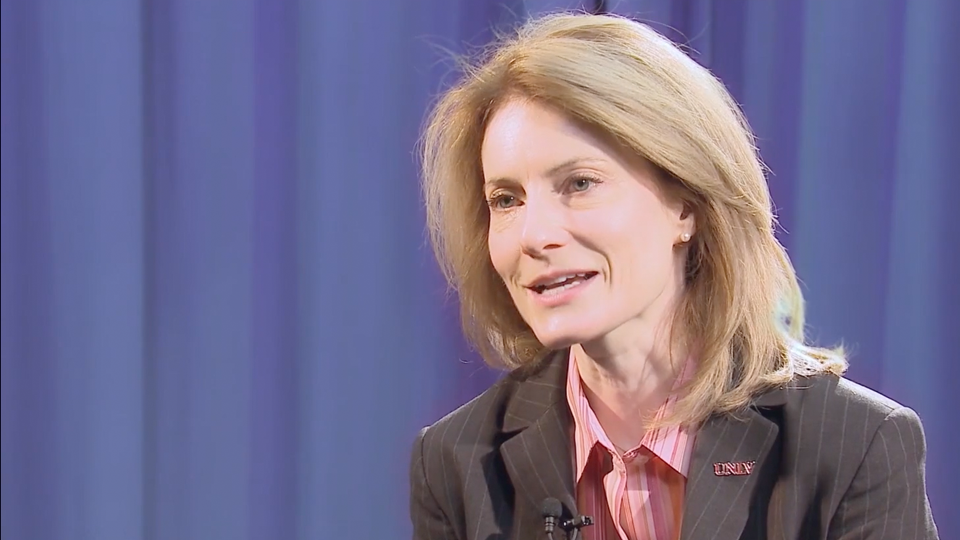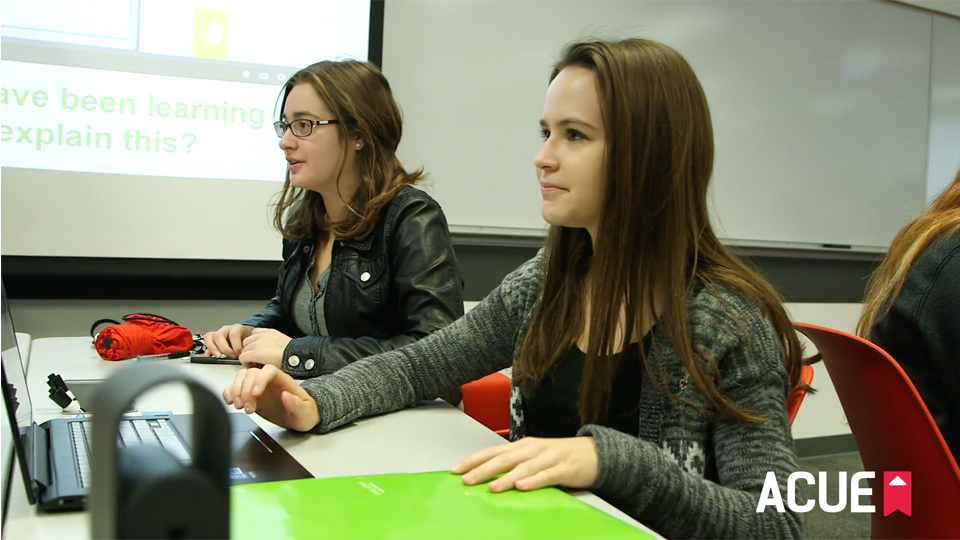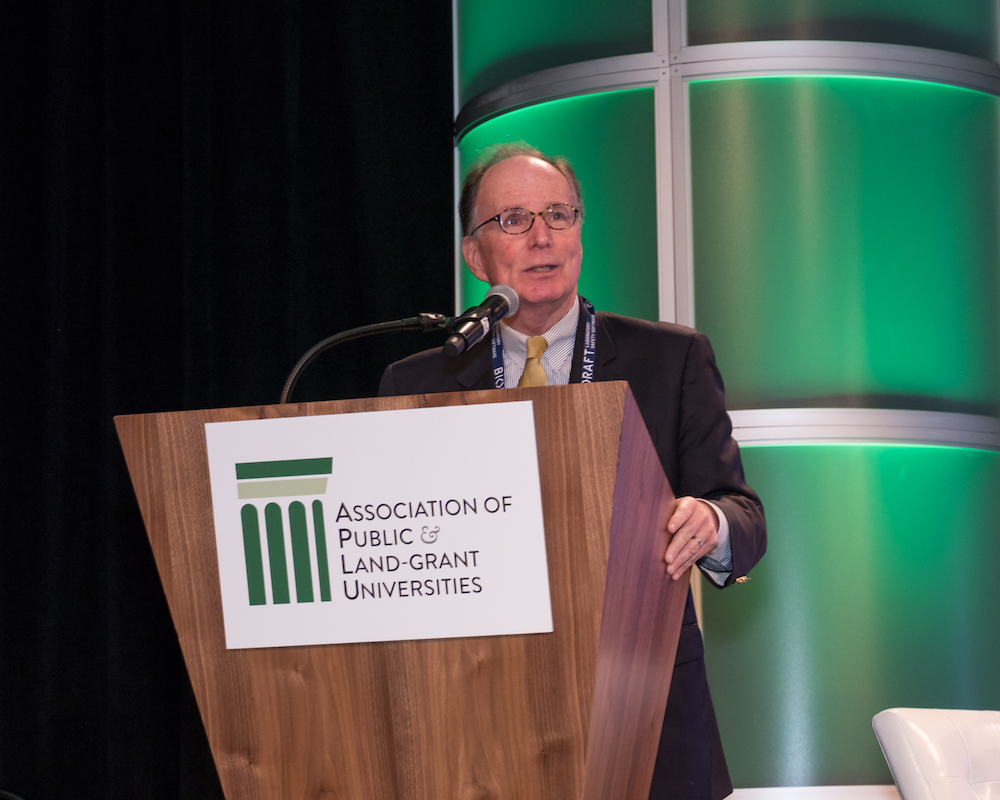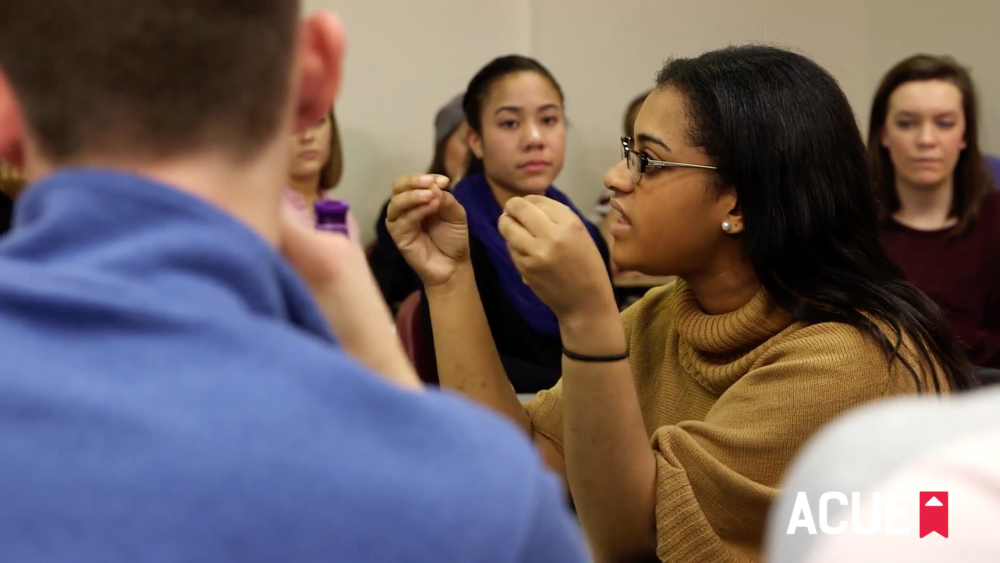



This week, Mary-Ann Winkelmes asks the question “If you could change one thing about your teaching, what would it be?” and shares three key guidelines to help you refine your practice. Plus, see how schools are increasing enthusiasm, personalizing lectures, and inspiring students from diverse and challenging backgrounds.
Mary-Ann Winkelmes writes that students with access to transparent instruction report a significant increase in academic confidence, sense of belonging, and skills that employers value. (The ‘Q’ Blog)
Faculty at the University of Southern Mississippi reflect on the semester and discuss their experience with ACUE’s Course in Effective Teaching Practices. (Southern Miss Now)
Thanks to the Second Chance Pell Pilot Program, which allows prisoners to apply for federal student aid, inmates are now able to earn degrees from select schools. (The Baltimore Sun)
Incorporating elements of contemporary culture like food, music, and television into lesson plans can increase both students’ and instructors’ enthusiasm for the material. (The Scholarly Teacher)
| Sign up for The ‘Q’ Newsletter for the latest news and insights about higher education teaching and learning. |
Universities are personalizing lectures by decreasing the number of students in the classroom as hundreds participate remotely. (The Chronicle of Higher Education — Paywall)
To increase understanding and awareness of online deception, one instructor had students create Twitter bots. (Digital Pedagogy Lab)
Grad student Anne Guarnera suggests three ways to collaborate on lesson planning: choose a compatible partner, develop a workable routine, and agree to hold one another accountable. (GradHacker)
Joshua Kim offers six recommendations for building strong online instruction, with a focus on providing personal attention. (Technology and Learning)
Competency-based programs, which focus on effectively teaching discrete skills, may transform faculty roles by dividing professors into program designers and teachers. (The Hechinger Report)
Faculty should encourage students with challenging circumstances to share their stories in order to build resilience and inspire others, psychologist Angela Duckworth writes. (Inside Higher Ed)
Two cognitive psychological scientists offer six techniques to improve study habits. (Cult of Pedagogy)

If you could change one thing about your teaching, what would it be?
That question was the catalyst for a quest that began nearly a decade ago, when I encouraged a group of educators at the University of Chicago and the University of Illinois at Urbana-Champaign to choose a teaching adjustment that they believed would most benefit their students. After a seminar series focusing on evidence-based teaching strategies, we realized that most faculty aren’t provided with the information needed to answer that challenge.
| Visit the ACUE Expert Series home page for more teaching insights. |
There is no shortage of research on effective strategies to consider, but which method will best serve the needs of my student population? What changes are sustainable given my current course structure? And how will I know if my adjustments are having an impact on my students’ learning?
As the academic term comes to a close, many college teachers may have similar questions. A break between semesters provides a good opportunity to reflect and prepare for new students and classes.
To answer these questions, the Chicago and Illinois faculty wanted more information about their own students’ learning experiences. This line of inquiry has been the focus of the Transparency in Learning and Teaching in Higher Education project (TILT Higher Ed) since the spring of 2008, when Chicago faculty contributed to designing the TILT Higher Ed online survey. Today, the survey consists of 14 demographic questions and 49 questions about students’ learning experiences. (View all the questions on the TILT Higher Ed survey web site.)
The surveys have proven to be a useful resource for individual teachers as they decided which adjustments might most benefit their particular students. But new research on data from TILT Higher Ed’s surveys is helping us establish a set of practical and relevant techniques that can guide any college instructor looking to make a small, sustainable adjustment this year.
Today’s college-going student population is dramatically different from just a few decades ago. Underrepresented, first-generation and low-income students now comprise the new majority of students entering our doors and online learning environments each year, and their completion rates lag far behind their peers.
In 2014, TILT Higher Ed and the Association of American Colleges & Universities teamed up to address this gap. At seven minority-serving institutions, our goal has been to scale the use of transparent instruction to significantly enhance underserved student success.
Transparent instruction promotes an inclusive learning environment where teachers and students engage in conversations about the relevance of academic work to students’ lives beyond college, as well as expectations for work process and performance. In the TILT–AAC&U study, teachers and students focused discussion on three aspects of students’ academic work: Purposes, Tasks, and Criteria.
As the word “tilt” suggests, a small adjustment to your teaching can offer students a transparent view of why and how you’ve structured their learning experiences. That’s why we asked the teachers in our study to select just two take-home assignments to redesign along TILT’s guidelines.
We provided all teachers with a Transparent Assignment Template as a guide, but we intentionally avoided rigid protocols for two main reasons. First, we expected variation. We knew that student–teacher communication could take place online or in brick-and-mortar classrooms, in synchronous or asynchronous conversations, in structured or unstructured discussions. Second, we wanted to demonstrate that any teacher can adopt Transparent Assignment Design at their own discretion to improve their students’ learning.
In our study, 35 teachers at seven institutions selected two assignments to revise based on the template guidelines below. Each instructor taught the same course to two different groups of students—amounting to a sample of 1,180 students. The difference was that the intervention group of students received the revised assignments and the control group of students got the original assignments.
When the study wrapped up last year, the results were encouraging.
The students with access to transparent instruction reported significantly higher levels of satisfaction in three areas considered to be important predictors of success: academic confidence, sense of belonging, and improvement of skills that employers value. The positive outcomes were even greater for first-generation, low-income, and traditionally underrepresented students [1].
In a similar, simultaneous study of 1,143 UNLV students, those with access to transparent instruction not only reported increases in these three categories, they also persisted at higher rates than students from the less-transparent groups. In the following academic year, retention rates for these students were significantly higher [2].
Faculty observations reflected these patterns. Faculty reported higher quality student work, less student resistance, and more on-time assignment submissions for the students who were part of the transparent instruction group [3].
You can begin laying the foundation for transparent instruction as you prepare for your first day of class in January. Over your break, start by identifying two assignments that you would like to revise. The goal of this review will be to give students a transparent view into how—and why—you’ve structured the learning experiences in your course.
Remember to consult our template and use your own discretion. Here are some other key guidelines to follow:
Students should understand the skills they will practice and the knowledge they will gain from selected assignments. They should also know how these skills and knowledge are relevant to their lives, and to their abilities to address real-world problems.
Teachers and students should discuss and understand the specific steps that may be required to complete the assignment. Which steps would be helpful? Which ones could be unproductive? The goal is not to pamper students, but to help them focus their time effectively on producing high quality work.
Students must have a clear understanding of what the teacher’s expectations are as well as the criteria being used to assess their learning. So students and teachers should engage in a review of, and discussion about, existing work examples (of varying quality) before students complete their own assignments.
In the module Aligning Activities and Assignments With Course Outcomes, part of ACUE’s Course in Effective Teaching Practices, my UNLV colleagues Anna C. Smedley-López, David Copeland, and Sharon Jalene further discuss how these practices benefitted students and helped them improve as instructors.
Visit TILT’s home page for sample materials around the transparent teaching process and more. To administer the TILT survey to your class, sign up here to participate.
Please also share your insights, experiences, and individual approaches to transparent instruction in the comments section.
Mary-Ann Winkelmes is a featured subject matter expert for Aligning Activities and Assignments With Course Outcomes, a module from ACUE’s Course in Effective Teaching Practices. She is the Coordinator of Instructional Development and Research at the University of Nevada, Las Vegas, Principal Investigator of the Transparency in Learning and Teaching Project, and a Senior Fellow at the Association of American Colleges & Universities.
Citations:

This week, the American Council on Education continues to emphasize the connections between student success and college teaching through its groundbreaking research initiative. Plus, find tips for combating prefinals exhaustion, building curriculum, and establishing new policies and practices in class.
Rather than falling into an end-of-semester rut, instructors should encourage students to reflect on how their thinking has changed and might continue to evolve. (Vitae)
Assessing the connections between teaching quality and student success is a vital step toward dramatically increasing the number of Americans able to earn a college degree, write American Council on Education’s Molly Corbett Broad and USA Funds’ William Hansen. (The Huffington Post)
Instructors can navigate a divisive postelection climate by facilitating effective discussions and promoting a civil learning environment, Shontavia Johnson and Jennifer Harvey write. (Inside Higher Ed)
One professor’s graduate students host sessions on Reddit’s science channel, helping them rethink classroom boundaries and combat the spread of misinformation online. (EdSurge)
Instead of enforcing an outright ban on electronics, faculty can set designated times for when and how students can use their devices during class. (Teaching in Higher Ed)
ACUE’s Kevin Reilly and Penny MacCormack presented on the pressing need for great teaching in higher education at this year’s APLU Annual Meeting. (The ‘Q’ Blog)
Maha Bali suggests ways of involving undergraduate students in conferences that will benefit both instructors and students, such as having students present or participate in professors’ presentations. (ProfHacker)
Teaching students to think creatively encourages them to develop new approaches to problem-solving. (Teaching for Learning @ McGill University)
Leaders from the Professional and Organizational Development (POD) Network in Higher Education have laid out eight principles to guide colleges and universities in adopting, implementing, and purchasing online faculty development programming. (Educause Review)
As part of a model designed to encourage personal learning experiences, Katie Martin poses eight “essential questions” that should be answered before getting started. (Institution for Entrepreneurship in Education)

We were proud to partner with the Association of Public Land-grant Universities for the group’s 129th Annual Meeting in Austin, Texas.
APLU is a research, policy, and advocacy organization that represents hundreds of public research universities across all of North America. Annually, APLU members enroll 4.7 million undergraduates and 1.2 million graduate students.
First day at #APLU2016. Who’s here and what did you learn? pic.twitter.com/vLk1qiEBkn
— ACUE (@ACUE_HQ) November 13, 2016
“Learning, Discovery, and Engagement” was the theme of last month’s three-day event and was the focus for many of the sessions and speeches. ACUE’s Kevin Reilly kicked off the event on Sunday evening with a call to action regarding the need for great teaching in higher education.
“We have paid too little attention to the connections between what goes on in our classrooms and whether our students are on course to earn their degree,” said Reilly, President Emeritus of the University of Wisconsin System. (Click here to read Reilly’s prepared remarks in full.)
Reilly also showed a video featuring leaders in higher education who amplified the urgency to make effective instruction a core component of the student success agenda. The video also showcased some of the classroom demonstrations and teaching techniques featured throughout ACUE’s Course in Effective Teaching Practices.
The next day, it was standing-room only for a presentation by ACUE Chief Academic Officer Penny MacCormack. In the presentation to presidents and provosts—titled “Great Teaching: The Missing Link in Your Student Success Agenda”—MacCormack discussed the research behind effective instruction and improved student outcomes.
Coming up at 10:15 in Griffin Hall: ACUE Chief Academic Officer, on the “missing link” in student success. #APLU2016 pic.twitter.com/SgJJa3gywT
— ACUE (@ACUE_HQ) November 14, 2016
APLU also recognized some of the many amazing instructors with teaching awards. Congrats to all of the winners!
Congrats @UFCALS @UFAEC alum @emilybbuck now @FoodAgEnvNews on a @USDA Teaching Award #APLU2016. @UFCALS alumni are the best! pic.twitter.com/u886GNNjwe
— UF IFAS CALS Dean (@UFCALSDean) November 13, 2016
Look at all those @OhioState #CFAES teaching award winners at #APLU2016. #excellence pic.twitter.com/rFn6Zz3z7m
— Susan Crowell (@scrowell) November 13, 2016
Thank you to APLU and its members for welcoming the ACUE team. Your commitment to student success is what inspires ACUE’s work every day. We look forward to #APLU2017!
Thank you to all #APLU2016 speakers and attendees for a successful and inspiring annual meeting in Austin, TX. pic.twitter.com/q2Hfm3RdSm
— APLU (@APLU_News) November 16, 2016

This week is jam-packed with instructors’ insights and ideas, like how to get students to write with passion and stimulating students through syllabi.
A Georgetown University researcher is testing new interventions to improve how people with dyslexia read, which could be a breakthrough for people with the learning disability. (nprEd)
Harnessing students’ emotions can provoke curiosity and create positive learning experiences. (Vitae)
Small group work and color-coded sticky notes are two techniques for teaching complicated technical skills in large classroom settings, according to George Williams. (ProfHacker)
Lectures are most effective when the instructor presents the content clearly, explains its value, and offers opportunities for reflection. (The Scholarly Teacher)
Betsy DeVos, President-elect Donald Trump’s pick for education secretary, has well-established views on elementary and secondary education, but her perspectives on higher education remain unclear. (The Chronicle of Higher Education — Paywall)
Connecticut College’s revamped curriculum helps students see how their academic experiences are relevant to their lives outside of the classroom. (The Chronicle of Higher Education)
Rather than merely conveying information, a syllabus should demonstrate how the course will stimulate and challenge students, Kevin Gannon suggests. (Vitae)
Thanks to databases of published materials, many instructors are turning to peers’ teaching portfolios to redesign their own lessons. (edSurge)
An English professor reveals how she encourages all students, even those who are not self-described writers, to craft essays with passion and conviction. (Inside Higher Ed)
Joshua Kim envisions a higher education classroom of mixed learning, where remote and residential students can learn together synchronously. (Technology and Learning)
Colleges should prioritize and create better systems for helping students develop critical thinking skills, Ben Paris argues. (Inside Higher Ed)